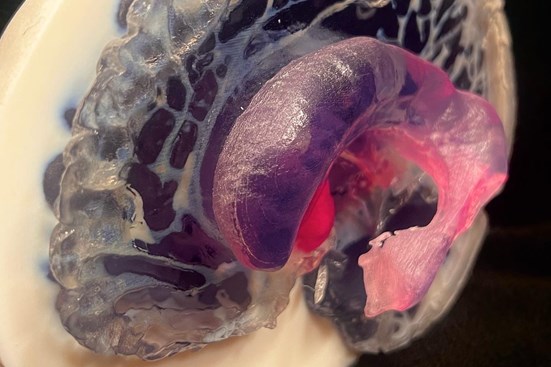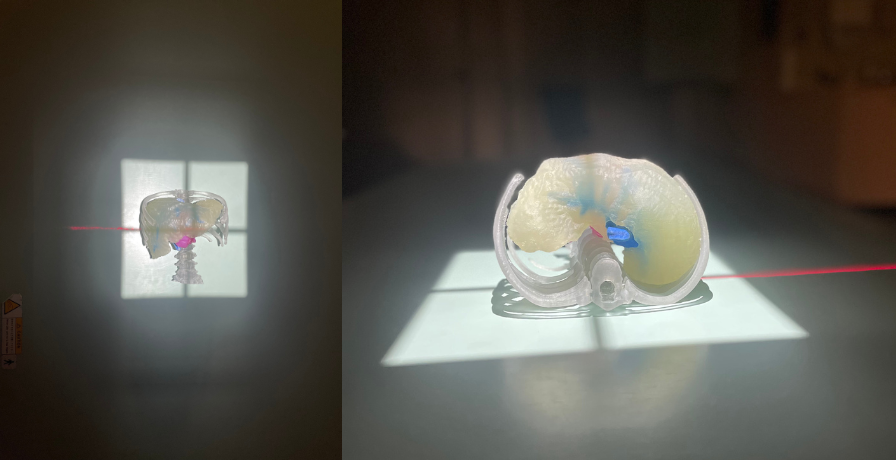Original news article posted here: Clarkson College Develops Unique 3D Printing Education Program Powered by Stratasys Digital Anatomy Technology.
Blair Kauzlarich, who serves as an adjunct faculty member and the 3D Printing and Training Administrator for Clarkson College in Omaha, Nebraska, has a personal connection to 3D printing; she’s been on the receiving end of patient education through 3D printing for a complex surgery. “Not only is it my job, but I’ve also lived it,” said Kauzlarich. “When my son was 10 months old, he was diagnosed with a brain tumor that needed to be removed.” Kauzlarich got a copy of her son’s CT and MRI scans from medical records and partnered with a radiologist to make a 3D version of her son’s brain. Through visualization with the 3D model, she and her husband were able to better understand how to proceed with her son’s care. And while the tumor did not end up being cancerous, Kauzlarich said that knowing specifically where the tumor was located helped them decide which method of surgery would be best.
"3D printing is a language we all speak. We are committed to excellence in learning by creating pathways that utilize 3D print in visualization as a language everyone can understand.” Patricia (Trish) Weber MHA, RT(R)(CT) ARRT, Associate Professor for the Clarkson College Radiography and Medical Imaging program
 3D Print head model with a rare brain tumor called ‘Choroid Plexus Papilloma Tumor’ within the third ventricle of the brain. So rare, CPP’s have an overall incidence of less than 1% of all intracranial brain tumors. This model was printed with Digital Anatomy Printer materials: VeroWhite, VeroClear and VeroMagenta.
3D Print head model with a rare brain tumor called ‘Choroid Plexus Papilloma Tumor’ within the third ventricle of the brain. So rare, CPP’s have an overall incidence of less than 1% of all intracranial brain tumors. This model was printed with Digital Anatomy Printer materials: VeroWhite, VeroClear and VeroMagenta.
Just months later, Kauzlarich helped start the new 3D Printing and Training Center at Clarkson College. Clarkson College offers certificate and degree programs in highly sought-after health care fields including nursing, health care business, and radiography. Thanks to Kauzlarich and her colleague Trish Weber, Associate Professor for the Clarkson College Radiography and Medical Imaging program, those certificate and training offerings now include 3D printing for pre-surgical planning and patient education in clinical settings, an offering which is sometimes limited to hospital settings. “Our print lab is unique because we’re not necessarily in a hospital hub,” Kauzlarich said. “Most print labs are housed within the walls of a hospital and are really only able to cater to people within their hospital or research, but we’re based in a college and able to serve people worldwide.”
"3D printing is so important because it helped my family at a time when we needed it. My husband and I were able to stay on the same page and make decisions together for our son’s care. In an uncertain time, it was replaced with a sense of certainty and calmness because we knew what was happening.” Blair Kauzlarich B.S., ARRT (R) CI, 3D Printing and Training Administrator at Clarkson College
Kauzlarich worked with Weber to develop a leading-edge 3D printing certification for registered radiologic technologists who are interested in applying 3D printing technology to the health care field. The Medical 3D Printing Specialist Certificate exposes technologists and providers—some of the members of her field who Kauzlarich found weren’t familiar with 3D visualization and printing—to 3D printing for surgical preparation and patient education.
Kauzlarich and Weber believe that this technology, which can help to improve patient care and outcomes by giving providers a way to study and practice on realistic models, will become the standard of care in facilities across the nation. They designed the certificate to give students hands-on experience with 3D printing software and printers that will prepare them to meet this market demand.
“We practice everything to be perfect, so why not surgery?” Kauzlarich said. “It’s like preparing for an exam. You prep, you study, and then you feel the most confident you can be. Our surgeons are able to use 3D printed models to practice—and in the real world they’re able to cut down on operating room costs, anesthesia, time on the table, and it results in a better outcome for the patient.”
“We have also found better patient compliance with 3D printed models,” Kauzlarich said. “Consent is easier when someone understands what is going on.”
As part of the Clarkson College 3D Printing and Training Center, Kauzlarich and Weber have also established a 3D printing lab that serves hospital partners, patients, and researchers worldwide, including Nebraska Medicine, a comprehensive health network in the Omaha, Nebraska region.
They use Stratasys Digital Anatomy™ technology in their lab because, after seeing and holding models created with the Digital Anatomy Printer and completing additional research, Kauzlarich believed that her team could enhance patient care and education through this technology.
Additionally, Kauzlarich and her team chose the Digital Anatomy Printer because of its versatility and because they found that through this technology, the lab is able to create anatomically realistic, biomechanically accurate models for physicians who need a visual way to explain a unique procedure or another specific anatomy.
“Recently, a private practice physician reached out to us who serves as a medical expert for workers’ compensation cases,” Kauzlarich said. “The patient-specific models we are able to create with the Digital Anatomy Printer are perfect to explain their case to a jury and improve patient advocacy.” With the support of the Clarkson College lab, surgeons who may not have the resources yet to establish their own 3D print lab can practice with multi-color, multi-materials models.
“3D printing is a language we all speak,” Weber said. “We are committed to excellence in learning by creating pathways that utilize 3D print in visualization as a language everyone can understand.”

3D Print liver model in xray field of view light. Students can practice abdominal radiographs in our energized x-ray lab.
ADVICE
What would you say to a facility who is interested in starting a 3D print lab but trying to find the funding?
- Reach out to a foundation; usually you can find people who are interested in 3D printing and can donate
- Find a lender who can do installments for the printer instead of a one-time large expense from your budget
- Have champions in the upper levels of leadership and demonstrate the value of this technology
Learn more about the 3D Printing and Training Center.


 3D Print head model with a rare brain tumor called ‘Choroid Plexus Papilloma Tumor’ within the third ventricle of the brain. So rare, CPP’s have an overall incidence of less than 1% of all intracranial brain tumors. This model was printed with Digital Anatomy Printer materials: VeroWhite, VeroClear and VeroMagenta.
3D Print head model with a rare brain tumor called ‘Choroid Plexus Papilloma Tumor’ within the third ventricle of the brain. So rare, CPP’s have an overall incidence of less than 1% of all intracranial brain tumors. This model was printed with Digital Anatomy Printer materials: VeroWhite, VeroClear and VeroMagenta.